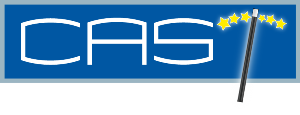Original URL: https://www.theregister.com/2012/04/16/saas_customisation/
How far can you shift the shape of cloud software?
Tweak and ye shall find
Posted in SaaS, 16th April 2012 11:30 GMT
Deep in the bowels of the EU academics, businesspeople and bureaucrats are putting the finishing touches to a set of specifications that could change the way we handle software as a service (SaaS).
 The €1.08m CAST project, funded by an EC program called Eurostars, was created to develop a framework for making cloud-hosted software customisable.
The €1.08m CAST project, funded by an EC program called Eurostars, was created to develop a framework for making cloud-hosted software customisable.
The academic and commercial partners behind the programme are tackling a problem that is becoming increasingly important for companies toying with the idea of SaaS: how much can you tweak it?
Customisation has always been a critical issue for business users. Fifteen years ago, we were discussing whether companies implementing ERP and CRM solutions should embark on major coding and customisation to bend the software to their will or adapt their business processes to fit more lightweight, standardised software. These days, that discussion has shifted to the cloud.
Do you adapt to fit the software that someone is hosting for you, or do you find a way to mould the software to fit your business? And do you have a choice?
The die is CAST
 Dimitrios Kourtesis is a research associate for the South-East European Research Centre (SEERC), a non-profit centre created by the University of Sheffield. SEERC was intimately involved with the CAST programme and it was Kourtesis’s job to make sure the modular SaaS framework the project was developing would be customisable, while still remaining cohesive.
Dimitrios Kourtesis is a research associate for the South-East European Research Centre (SEERC), a non-profit centre created by the University of Sheffield. SEERC was intimately involved with the CAST programme and it was Kourtesis’s job to make sure the modular SaaS framework the project was developing would be customisable, while still remaining cohesive.
“Our project was about a new development and deployment model, and a new way of looking at customisation for on-demand business applications,” he says.
“It was about how to create a governance solution that prevents such a platform from spinning out of control.“
CAST focuses not just on basic SaaS customisation but on taking a variety of web services, service-oriented architecture-style, and bolting them together in the cloud. The danger is that such solutions might cause performance problems between different services.
The programme, which ended in July, will lead to a commercial platform due to be rolled out within 18 months.
The goal is that companies should be able to create their own business applications and combine them with the apps offered by the platform provider or third parties. They should be able to integrate them with external systems using web services, and offer the result as a new SaaS solution. It is essentially service-oriented architecture writ in the cloud.
For most of us, making software work the way that we want it in the cloud is a big enough challenge without getting into bolting together web services modules. But it depends how far you want to go.
Wizard tricks
Barry Cousins, senior research analyst at Canadian firm Info-Tech Research, makes the distinction between customisation and configuration.
“Today, more things can be done through a user interface, and that is what has changed,” he says. “The vendors have made their software more flexible and configurable.”
The line between configuration and customisation, according to Cousins, is what you cross when you get into writing code. “It’s when you are creating something that is unique enough that the vendor can’t upgrade the base product around it,” he says.
But you don’t have to be a geek to tweak. He points to Enterprise Wizard, a company offering a SaaS-based solution designed to support a business with a variety of process templates, covering everything from change control through to contract and lead management.
The interesting part is that you can not only bolt together modules programmed by the provider, but also configure work and process flow using a familiar flowchart interface, without coding.
SaaS offerings such as these sit at the junction between SaaS and platform as a service (PaaS). The difference is that with PaaS you can write code yourself.
Examples include Force.com, which uses the Apex programming language. Another is Zoho Creator, which uses a mixture of drag-and-drop forms design along with the firm’s Deluge scripting language to produce business rules workflow.
The options to customise heavily are available to SaaS customers, then, but do you really want to go there? Much depends on how much you have to spend and what you want to change.
“The cost is no different from having a custom on-premise application. It’s not a linear curve,” says Cousins.
The cost curve is exponential, he says. The more unique functionality you put into a SaaS application, and the more nuanced the data structures, the higher the rate of escalation.
All the traditional activities surrounding customisation apply. Customers that want to be developers must handle regression testing against their own code and the base product.
“The bulk of the SaaS vendor ‘customisations’ that I see are really configurations, and it’s a lot closer to linear,” says Cousins.
“The sweet spot is in the 500 to 2000 employee range”
If you decide to get into SaaS customisation, should you do it in-house? Cousins thinks it is better to call in help from a service provider with experience of modifying a particular vendor’s SaaS solution.
“You can get so far so fast that the return is high,” he says. “And you have the benefit of using that as a training experience, so that your own people can take the task on later.”
The alternative is to challenge the vendor before you sign the contract. Ask the vendor how to produce a given result without writing code.
“These are the things that the vendor could lead you through. I want the vendor to help show me the right way to do it,” says Cousins.
With the cost curve rising sharply for heavily customised SaaS deployments, perhaps it is unsurprising that heavyweight customisation is restricted mostly to larger firms.
“The cost of sale points you towards large organisations. Guiding someone through what they are going to get from an accounting, invoice or billing application is a cost for providers that they are not always willing to take on board,” says Hamish Macarthur, CEO at advisory firm Macarthur Stroud International.
“The sweet spot is in the 500 to 2000 employee range, because the larger ones will have their own systems in place, and the small ones become too expensive to sell to.”
The signs are that the real growth opportunities for SaaS lie in the small business space, according to Cisco.
The company says that over the next two years, the number of SMEs investing more than 30 per cent of their IT budgets in cloud computing will grow by 260 per cent. More than half of all SMEs will be spending more than this level on cloud computing by 2013.
Go configure
With many small businesses just wanting to simplify their IT and get away from complex investments, customisation is therefore unlikely to play a big part. Configuration will be the main game in town.
You will find few customisation options for multi-tenanted SaaS implementations of Office-based applications such as Sharepoint, says Steve Marsh, EMEA product manager at Microsoft provider Metalogix.
Microsoft makes the distinction between configuration and customisation very clear. Things change when you are dealing with a dedicated hosted Sharepoint environment, though.
“You can do a little more with that, because it’s understood that if it breaks, it’s up to you to fix your servers,” Marsh says.
“This is where we are seeing lot of service providers looking, because then the scope for customisations becomes broader. But it’s also where the hybrid cloud comes into play.”
Customers wanting straightforward collaboration solutions will be happy enough with a shared online system that they can tweak moderately, but more complex implementations might benefit from an on-premise element.
“We are seeing some Metalogix customers using migration technology to support that," says Marsh.
"Migration products and technologies are not used for one-shot migration. It’s about content management, and the concept of moving from cloud to on-premise.”
Flexible framework
While small businesses struggle with tweaking simple SaaS implementations to fit their processes, Cast’s partners will be taking the results of the project and using it to implement a far more flexible software framework.
Apps can be customised in three different ways, says Kourtesis: using configuration-only, configuration and client-side coding, or by the addition of server-side logic. The deliverable will be a combined registry and repository system, built on the WS02 governance registry .
It centres on creating a system of record, where all of the SaaS platform’s entities are stored and organised. In this way, companies assembling service oriented architecture-style apps in a SaaS environment can handle functions including lifecycle management, policy conformance and dependency tracking.
Cast’s framework sounds promising. The catch? The European taxpayer won’t get to see it. The code will be owned by what the EU calls “research-performing SMEs”.
In any case, these lofty cloud-based manipulations will be far more than most of us need. ®